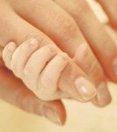Mumps Virus
Mumps virus is a member of the paramyxovirus family of viruses. The acute viral disease is spread from person to person by coughing or sneezing.
The infection is most contagious from three days prior to and four days after the onset of symptoms.
The incubation period is usually 14 to 18 days, although it may vary from 7 to 23 days.
The incidence of mumps infection during pregnancy is between 0.8 and 10 cases per 10,000 pregnancies[1].
The illness typically presents with fever, myalgia, and swelling and tenderness of one or more of the salivary glands, usually the parotid gland. About one-third of infected people do not have symptoms.
In women mumps may cause aseptic meningitis, mastitis, thyroiditis, glomerulonephritis, myocarditis, pancreatitis, and arthritis [1].
Mumps infection during the first trimester of pregnancy has been associated with an increased rate of spontaneous abortion[2]. Although mumps virus is capable of infecting the placenta and fetus, several studies have failed to demonstrate an association between gestational mumps and fetal malformation.[3,4].
There is, however, continued debate regarding a possible association between intrauterine mumps and endocardial fibroelastosis[5,6].
Congentially acquired mumps may sometimes lead to respiratory distress in the neonate[7-10]. Neonatal thrombocytopenia and splenomegaly has also been reported following perinatl infection[11].
Live attenuated mumps virus: Mumps vaccine virus has been been recovered from the placenta, but not from the fetal tissues of pregnant women who were vaccinated before undergoing elective abortions[12].
REFERENCES:
1. Gershon AA. Chickenpox, Measles, and Mumps. In Remington JS, Klein JO (eds). Infectious Diseases of the Fetus and Newborn Infant. Philadelphia, W.B Saunders Company, 2001, pp718-722
2. Siegel M, Fuerst HT, Peress NS. Comparative fetal mortaltiy in matenal virus diseases: a prospective study on rubella, measles, mumps, chickenpox, and hepatitis N Engl J Med 274:768, 1966
3. Siegel M. Congenital malformations following chickenpox, measles, mumps, and hepatitis. Results of a cohort study.
JAMA. 226:1521-1524. 1973
MEDLINE
4. Shepard TH. Catalog of Teratogenic Agents.pp1867 9th ed.Baltimore,MD: Johns Hopkins University Press, 1998
5. Finland M. Mumps. In Charles D, Finland M (eds). Obstetric and Perinatal Infections. Philadelphia, Lea & Febiger, 1973, p333
6. Ni J, Bowles NE, Kim YH, Demmler G, Kearney D, Bricker JT, Towbin JA.Viral infection of the myocardium in endocardial fibroelastosis. Molecular evidence for the role of mumps virus as an etiologic agent.
Circulation. 1997 Jan 7;95(1):133-9.
MEDLINE
7. Jones JF, Ray CG, Fulginiti VA. Perinatal mumps infection.
J Pediatr. 96:912-4, 1980
MEDLINE
8. Reman O, Freymuth F, Laloum D, Bonte JF. Neonatal respiratory distress due to mumps.
Arch Dis Child. 61:80-1, 1986
MEDLINE
9. Groenendaal F, Rothbarth PH, van den Anker JN, Spritzer R.Congenital mumps pneumonia: a rare cause of neonatal respiratory distress.
Acta Paediatr Scand. 79:1252-4, 1990
MEDLINE
10. Takahashi Y, Teranishi A, Yamada Y, Yoshida Y, Hashimoto K, Sakamoto Y, Morikawa H, Giddings J, Yoshioka A A case of congenital mumps infection complicated with persistent pulmonary hypertension.
Am J Perinatol. 15:409-12.1998
MEDLINE
11. Lacour M, Maherzi M, Vienny H, Suter S.Thrombocytopenia in a case of neonatal mumps infection: evidence for further clinical presentations.
Eur J Pediatr. 152:739-41. 1993
MEDLINE
12.Yamauchi T, Wilson C, Geme JW Jr. Transmission of live, attenuated mumps virus to the human placenta.
N Engl J Med. 290:710-2, 1974
MEDLINE
Created: 12/10/2000
Last update: 1/2/2003
